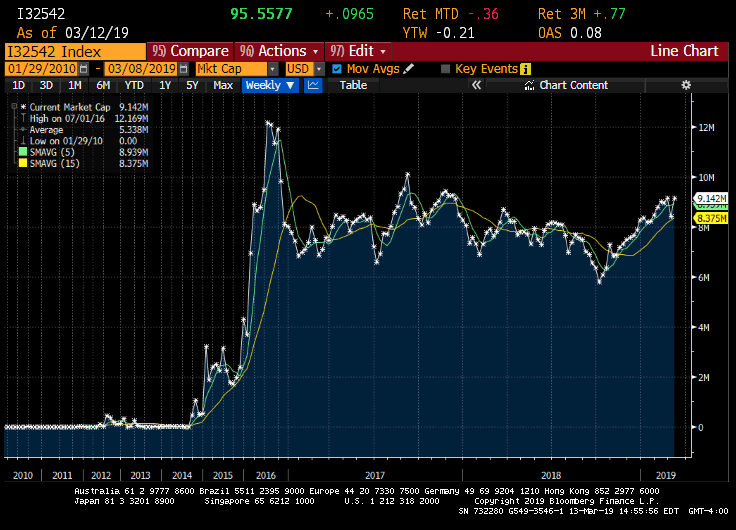Submitted by Philip Grant of Grant’s Almost Daily, courtesy of Grant’s Interest Rate Observer
Patent pending
A new chapter in financial innovation. From Barron’s yesterday:
Salt Financial, an exchange-traded fund shop with less than two years under its belt, filed on Tuesday to launch an ETF that will actually pay investors for investing in it, at least at the start. The negative-fee ETF is finally here, making online lender Social Financial or SoFi’s zero-fee ETFs old news.
Like SoFi’s zero-fee ETFs, Salt’s ETF will effectively zero out the cost and then some via what is called a management fee waiver. Salt’s investment advisor has pledged to add 0.05% [five basis points] of assets to the ETF, but only on the first $100 million in assets or until April 30, 2020. Once the ETF crosses that level or hits that date, it will charge its true fee of 29 basis points.
Negative-fee investment products may be the hot new thing, but a more familiar, if equally confounding, phenomenon persists: Lenders paying borrowers for taking their money. After falling below $6 trillion last year, the Bloomberg Barclays Global Aggregate Negative Yielding Debt Index has seen its market capitalization jump back above $9 trillion. On the authority of Sidney Homer and Richard Sylla, negative interest rates had not been seen in substantial size during 3,000 years of financial history prior to this cycle.

Arc of the covenant
An analysis from S&P’s LCD unit yesterday calculated that the trailing 12-month default rate for leveraged loans has fallen to just 0.93%, down from 1.62% in February and from a long-term average of 3.1%. The sharp sequential decline is the result of iHeartMedia, Inc., which defaulted last March, being removed from the trailing 12-month calculation.
The low default rate provides another enticement to lend and borrow. LCD reports that institutional loans outstanding in the U.S. now total a record $1.17 trillion, up from $1 trillion last May. Across the U.S. and Europe, total term loans outstanding have doubled in the last 10 years to $2.65 trillion, according to the Bank for International Settlements.
That breakneck growth pace is making regulators nervous. Last Thursday, the Financial Times reported that the Financial Stability Board is investigating components of the leveraged loan market, particularly the practice of bundling loans into collateralized loan obligations (according to LCD, CLOs now account for 50% to 60% of U.S. leveraged loans). On Feb. 28, Bloomberg reported that Japan’s Financial Services Agency has been questioning local lenders about their CLO concentration, particularly Norinchukin Bank, which itself holds a nearly $62 billion CLO portfolio (roughly 9% of global supply) and bought one-third of all U.S. and European issuance in the fourth quarter (Almost Daily Grant’s, Feb. 21).
A Sept. 7 cautionary Grant’s CLO analysis, noting that the securities are divided into tranches based on risk profile and recovery potential, called attention to the acute cyclical risks that reside in the lower-rated and higher-yielding tranches:
It’s not quite true that a CLO is only as good as its loans. What is true is that a portion of a CLO is only as good as its loans, that portion being the junior one, equity and mezzanine debt. Deterioration in the quality of late-boom debt puts those segments at risk.
Late-boom conditions are on full display. Yesterday brought word that Moody’s covenant quality indicator reached a record-worst in February, eclipsing the prior nadir set in August 2015. The deterioration is comprehensive, as the agency notes that “weak covenant packages are clearing the market in all rating categories.”
Meanwhile, high profile deals continue to push the envelope. Yesterday, Bloomberg reported that a $10 billion loan and bond syndication financing Brookfield Asset Management, Inc. and Caisse de dépôt et placement du Québec’s leveraged buyout of Johnson Controls International plc is attracting strong bidding interest, “even after Xtract Research categorized its covenants, terms that protect investors, as some of the weakest and ‘most aggressive’ the firm’s analysts have seen.” Yield indications are now below initial guidance, even though some investors “had balked in particular at terms related to how easily the company can pay itself dividends.”
via ZeroHedge News https://ift.tt/2Uw00sF Tyler Durden